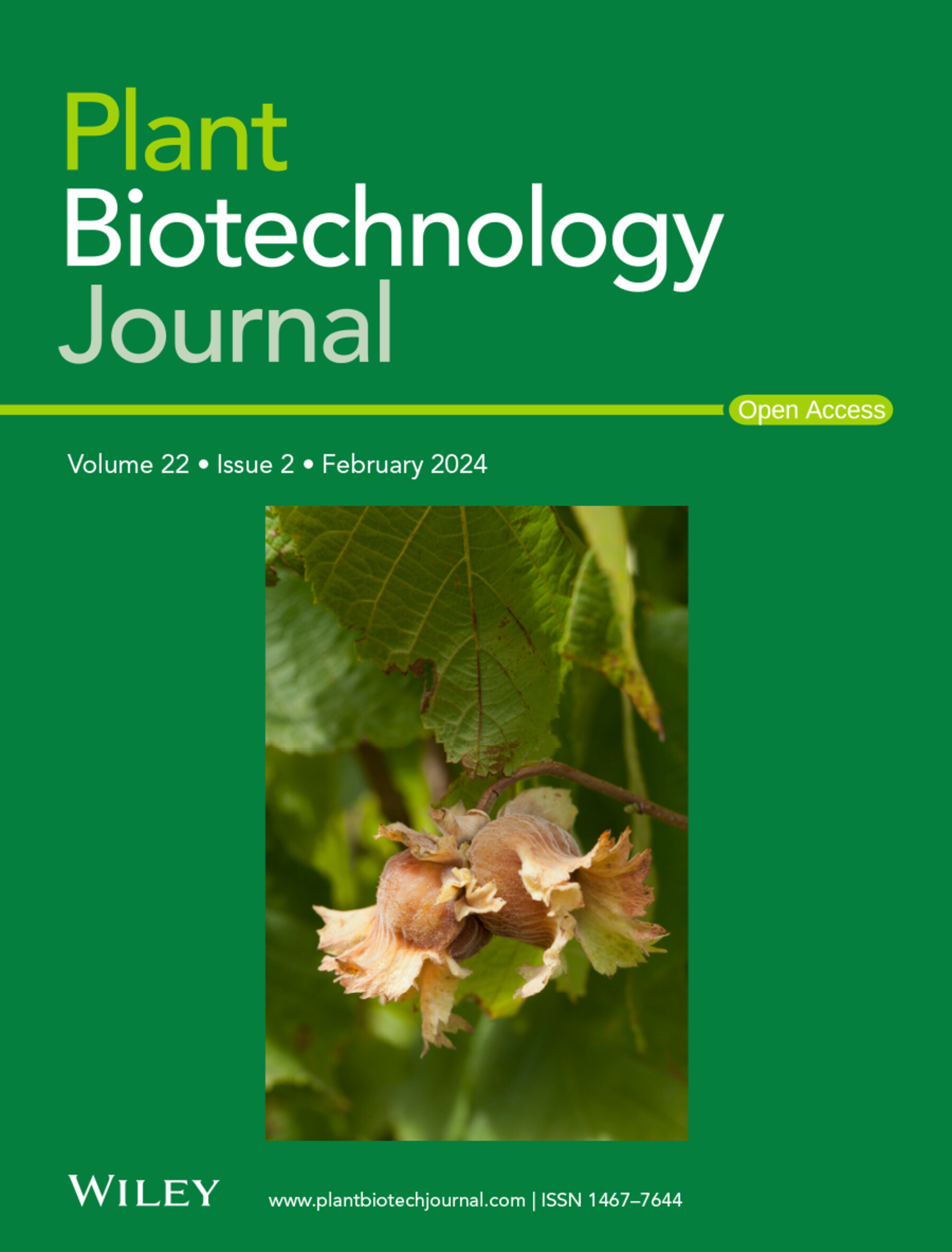过量分泌阿铁酰辅酶a 6′-羟化酶的转基因杂交杨木中木质素的光致发光特性
IF 10.5
1区 生物学
Q1 BIOTECHNOLOGY & APPLIED MICROBIOLOGY
引用次数: 0
摘要
木质素是木质生物质的主要细胞壁成分,具有光致发光(PL)特性。控制PL的强度和颜色对于生产木质素基增值材料至关重要。在此,我们通过新的发光团结构的基因工程来修饰木质素的发光特性。阿魏酰辅酶a 6′-羟化酶(f6′h1)是一种2-氧戊二酸依赖的双加氧酶,它催化阿魏酰辅酶a(单脂醇生物合成途径的中间体)转化为东莨菪碱的前体6′-羟基阿魏酰辅酶a。为修饰木质素PL特性,拟南芥F6'H1基因(F6'H1)在杂交杨树(Populus tremula × tremuloides T89)中过表达,将东莨菪素纳入木质素分子中。从不同过表达F6'H1的转基因白杨树中分离到纤维素水解酶木质素(CEL),并对其PL特性进行了评价。在n - n -二甲基甲酰胺溶液中,与野生型相比,f6 ' h1过表达的白杨细胞发出的荧光强度更高,波长更长。粒径排阻色谱法显示发色团的摩尔质量分布很宽。有趣的是,来自F6'H1转基因系的CEL的PL在低极性溶剂和高浓度下被有限地猝灭。F6'H1的CEL不仅在溶液中,而且在聚合物薄膜中都有明显的发光。此外,F6'H1系的CEL表现出香豆素可逆的光二聚化反应特征。这些结果表明,基因工程可以将新的发光团(如东莨菪碱)加入木质素中,从而生产出增值材料。本文章由计算机程序翻译,如有差异,请以英文原文为准。
Photoluminescence Properties of Lignin With a Genetically Introduced Luminophore in a Transgenic Hybrid Aspen That Overproduces Feruloyl-CoA 6'-Hydroxylase.
Lignin, a major cell-wall component of woody biomass, exhibits photoluminescent (PL) properties. Controlling the intensity and colour of the PL is essential for producing lignin-based value-added materials. Herein, we modify the PL properties of lignin via genetic engineering of novel luminophore structures. Feruloyl-CoA 6'-hydroxylase (F6'H1) is a 2-oxoglutarate-dependent dioxygenase that catalyses the conversion of feruloyl-CoA, an intermediate of the biosynthesis pathway of monolignol, into 6'-hydroxyferuloyl-CoA, the precursor of scopoletin. To modify the lignin PL properties, the F6'H1 gene (F6'H1) from Arabidopsis thaliana is overexpressed in the hybrid aspen (Populus tremula × tremuloides T89), incorporating scopoletin into the lignin molecule. Cellulolytic enzyme lignin (CEL) was isolated from transgenic aspens with different overexpression levels of F6'H1 and evaluated for its PL properties. In N.N-dimethylformamide solution, CEL from the F6'H1-overexpressed aspen emitted clear PL with higher intensity and a longer wavelength than the wild-type CEL. Size exclusion chromatography revealed a wide molar mass distribution of the chromophore. Interestingly, the PL of the CEL from the F6'H1 transgenic lines was limitedly quenched in low polar solvents and at high concentrations. The CEL from F6'H1 emitted obvious PL not only in solution but also in polymer film. Furthermore, the CEL of F6'H1 lines exhibited a reversible photodimerisation reaction characteristic of coumarins. These results suggest that genetic engineering can incorporate new luminophores such as scopoletin into lignin, thus producing value-added materials.
求助全文
通过发布文献求助,成功后即可免费获取论文全文。
去求助
来源期刊

Plant Biotechnology Journal
生物-生物工程与应用微生物
CiteScore
20.50
自引率
2.90%
发文量
201
审稿时长
1 months
期刊介绍:
Plant Biotechnology Journal aspires to publish original research and insightful reviews of high impact, authored by prominent researchers in applied plant science. The journal places a special emphasis on molecular plant sciences and their practical applications through plant biotechnology. Our goal is to establish a platform for showcasing significant advances in the field, encompassing curiosity-driven studies with potential applications, strategic research in plant biotechnology, scientific analysis of crucial issues for the beneficial utilization of plant sciences, and assessments of the performance of plant biotechnology products in practical applications.
 求助内容:
求助内容: 应助结果提醒方式:
应助结果提醒方式:


